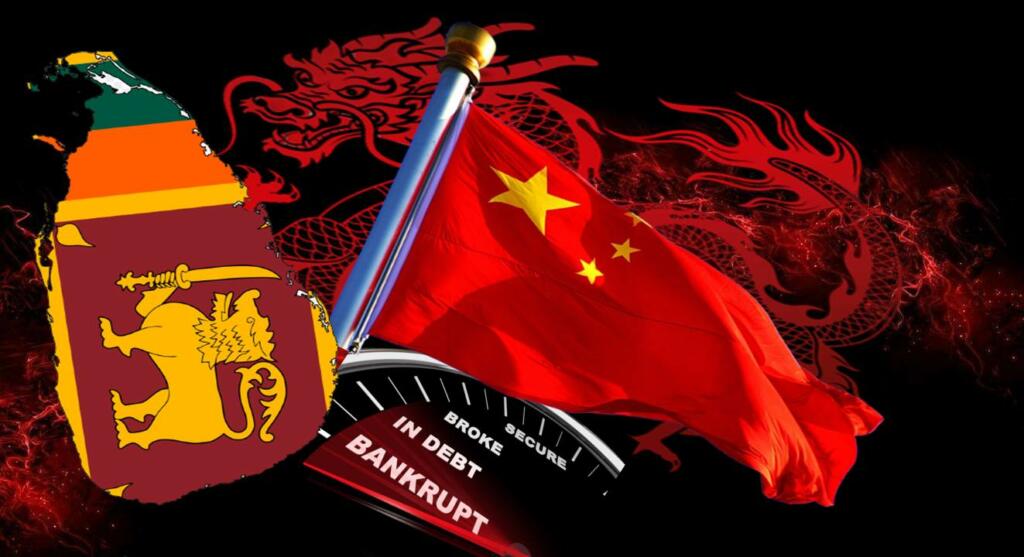Sri Lanka is in the middle of a huge economic crisis. It has simply run out of foreign exchange and is now staring at the possibility of failing to meet its foreign debt. The paper Dragon is staring at the island country, with an intention to colonize it. So, the lesson for other South Asian countries is clear- stay close to India or watch yourself crumble.
- Sri Lanka has to repay US$7 billion in foreign debt but it only had US$2.31 billion in official reserves as of February.
- Inflation is at a steep high of 15%.
- Supplies of crude oil are running out, printers do not have sufficient foreign exchange to buy imported paper and the island country isn’t able to import milk powder for babies.
How China reached out to Sri Lanka?
It was during the civil war in Sri Lanka that Beijing found a window of opportunity to make ingress into Colombo.
Sri Lanka faced international backlash over allegations of serious human rights violations. China however supported Colombo by supplying arms and using its veto power to shoot down UN resolutions against the island nation.
The next thing we know, Sri Lanka was allowing China to finance infrastructure projects in its territory. And it all started with the infamous Hambantota port project in 2007.
Read more: How Sri Lanka’s Hambantota became a Colony of China
How Sri Lanka got debt-trapped?
Soon, China was funding many infrastructure projects in Sri Lanka. Chinese debt and equity are estimated to fund more than 50 projects worth over $11 billion in the island country.
China is building roads, ports, water treatment plants and power plants in the country. The most notable and controversial of these projects however are the Hambantota Port, the Colombo Port City and the Lakavijaya thermal power plant. All these three projects were funded by Chinese government-owned banks and built by Chinese contractors.
So, where did things go wrong? Well, China charged a very high interest rate for its investments. Interest rates on some of the Chinese loans went as high as 6.5% compared to rates of 2.5%-3% for loans granted by the Asian Development Bank or the World Bank.
And then, there was conflict of interest. The financier and the contractor were both Chinese in many cases and therefore Beijing might have managed to overstate the costs incurred. Ultimately, the weight of an enhanced debt burden fell on Sri Lanka’s economy.
Finally, in 2017, the effect of Chinese debt-trapping became clear as Sri Lanka had to give away the Hambantota Port to China on a 99-year lease. During 2017, Sri Lanka was also found to be spending 83% of its revenues on debt repayments, a quarter of which was devoted to foreign borrowings.
Read more: ‘You made us bankrupt,’ Sri Lanka sends a warning to Xi Jinping as India bags a massive deal
Call it Sri Lanka’s misfortune, the Pandemic struck at a time when the island nation was particularly vulnerable. Colombo’s ability to raise foreign exchange through tourism got severely curtailed and the country saw its debts spiral and foreign exchange reserves shrink.
Over the last two years, Sri Lanka’s reserved have dipped 70 percent.The Pandemic crumbled Sri Lanka’s economy that was already stressed by Chinese debt of nearly $8 billion.
And this is where Beijing ensured that it won’t let Sri Lanka get out of this mess. In December 2021, Sri Lanka’s President Gotabaya Rajapaksa went to China with a request for debt restructuring. However, China reportedly refused to do so.
What next? Sri Lanka needed money to sustain itself. So, it approached China again on March 21 for a $2.5 billion loan request. China is considering the request and will most probably grant it. After all, it will deepen Chinese debt in Sri Lanka and give it even more leverage in the island country.
Sri Lanka, thus, seems to be heading towards effective colonization by China.
Lesson for other countries
The Sri Lanka episode is a lesson for other countries about what China can do to your economy. A media report stated, “The key concern, however, is how such a negative situation would impact the attitude of Colombo towards borrowings from China, and what it would mean for the ultimate relation between China and Sri Lanka. There is concern that the experience of Sri Lanka is prompting countries like Myanmar, Malaysia and Nepal to suspend Chinese investment projects.”
South Asia is passing through a phase of great uncertainty. For countries like Nepal and Myanmar, it is a lesson- stay close to India and avoid falling in the Chinese debt trap.
